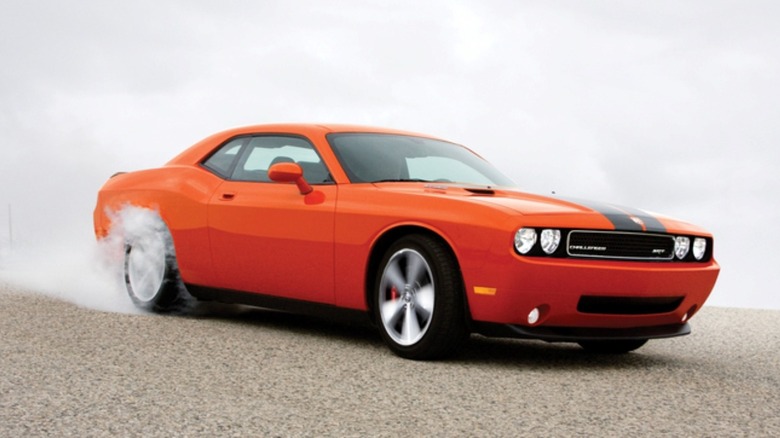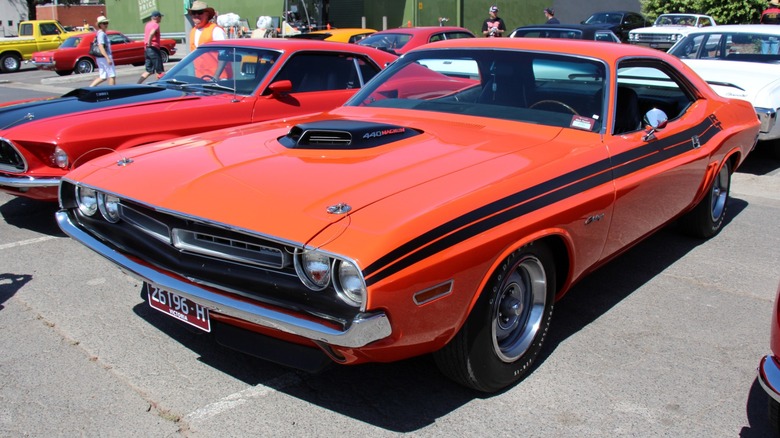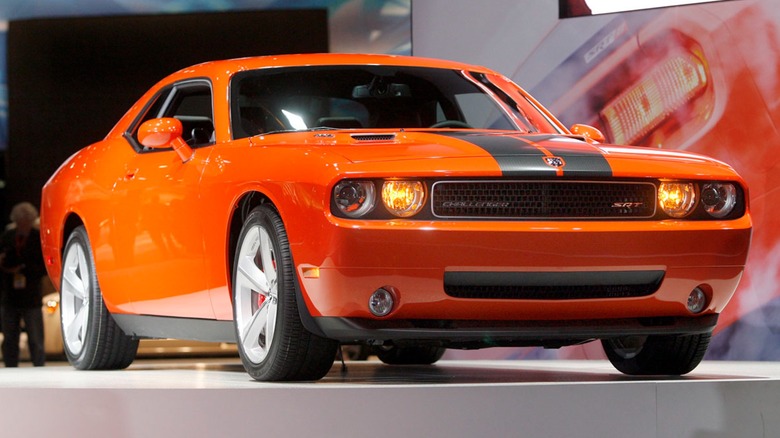6 Of The Best Looking Dodge Challenger Models Ever Built
Dodge introduced the Challenger as a 1970 model based on Chrysler's E-body platform. The Challenger entered a pony car segment that was already filled with popular contenders like the Ford Mustang, Pontiac Firebird, Chevy Camaro, and its corporate rival, the Plymouth Barracuda.
Over the years, Dodge has produced three distinct generations of Challenger model, placing it firmly among the most iconic Mopar cars ever built. The first-generation Challenger, produced from 1970 to 1973, exudes muscle car-era charm and along with the third-generation, 2008 to 2023, featured some of the most powerful engine options ever put in a Dodge Challenger. Those options included the 425-hp 426 HEMI for first-gen Challengers and the supercharged 6.2L HEMI Hellephant C170 V8 in the third-gen SRT Demon 170 Challenger.
The second generation of Dodge Challenger, spanning the 1978 to 1983 model years, is the outlier among the predominantly muscle car lineage. While Chrysler intended a Challenger-badged Japanese import, which Plymouth called the Sapporo, to be an upscale economy sports car, it could hardly compete with Ford's Fox Body Mustang introduced in 1979.
While all three generations have unique attributes, the most attractive models come from the odd generations. Let's take a look at six of the best-looking Dodge Challenger models ever built.
The inaugural 1970 Dodge Challenger R/T
The 1970 Dodge Challenger R/T isn't just iconic because it launched the first generation of the Challenger model, it's a very nice-looking car. The two-door hardtop coupe R/T featured paired headlights on either side of a short grille. A horizontal body line extended from the front edge of the fender to rear of the quarter panel, bulging as it passed over the rear tire on each side. The bulge, often accentuated by a contrasting stripe, defined the Challenger's muscular appearance.
Various paint and striping schemes were available. However, the black stripe starting at the front of the hood and extending back between, then over the twin hood scoops along with a contrasting Bumble Bee stripe around the Challenger's tail was the most attractive options.
The 1970 Challenger R/T came with a 335-hp 383-cubic-inch V8 that produced 425 lb-ft of torque. Other options included the 440 Magnum and 426 HEMI V8s. Transmission offerings included three- and four-speed manual shift varieties as well as a three-speed automatic transmission but varied depending on the selected engine option.
[Featured image by MrWalkr via Wikimedia Commons | Cropped and scaled | CC BY-SA 4.0]
Dodge changed the Challenger grille for 1971
The Dodge Challenger didn't change much in its sophomore year. The new pinstriping running the length of the car was split into two lines, ending just under the edge of the rear side windows after starting at the front edge of the fender. The new stripes were also placed just above the body side-line instead of on it.
While the Shaker-style hood scoop was available in 1970, it looks best on the 1971 model as its forward-pointed design carries through to the 1971 Challenger's new twin-inlet grille. The new grille design features raised chrome lines, one bisecting the grille top to bottom and another pair from side to side, meeting prominently in the center.
Engine options for the 1971 Dodge Challenger remained largely unchanged. Although output from the 383 was downgraded to 300 horsepower as the auto industry unknowingly slipped into the Malaise Era. Fortunately, the 440 Magnum and 426 HEMI continued to operate unhindered by the changing times.
[Featured image by Sicnag via Wikimedia Commons | Cropped and scaled | CC BY-SA 2.0]
The 1972 Dodge Challenger Rallye featured more than cosmetic changes
Not every Dodge Challenger had hood scoops accented by black trim, but the best looking models do, and the 1972 Challenger was no exception. The rather ornate grille design of the 1971 model was gone, replaced by a simple black vented design framed by a single chrome strip.
Other similarities to previous model years included the twin headlights on each side and horizontal body side-lines running the length of the car. The classic contrasting hood and side trim was still available, but the new fender vents added an eye-catching detail and appeared poised to remove some hot air from the engine bay, although the fender vents were non-functional.
Engine options for the 1972 Dodge Challenger evolved to include offerings more suitable to operating on the recently introduced unleaded gasoline. As such, the 1972 Challenger was only available with one of three engines: a 110-hp 225-cubic-inch Slant Six (one of the most reliable Chrysler engines ever made), a 150-hp 318 V8, or a 240-hp 340 V8. While those numbers sound terrible, and they were greatly reduced from previous engine offerings, it's important to remember that this was the period of transition from gross values to SAE net power ratings. The result, about a 25% reduction just by changing the measuring system, according to Stellantis.
[Featured image by Valder137 via Wikimedia Commons | Cropped and scaled | CC BY-SA 2.0]
The retro-styled 2008 Dodge Challenger SRT8
While we know the S197 Ford Mustang kicked off the retro-style trend in 2005, some may argue that Dodge raised the bar with its 2008 Challenger. The Stellantis press release for the 2008 Challenger SRT8 hailed its introduction as the return of the "iconic Dodge muscle car ... after a 35-year absence." A statement that completely ignores the existence of the second-generation Challenger.
There's little doubt that the designers responsible for bringing us the third-gen Challenger leaned heavily on the design of the original. In addition to the basics of its long front-clip, short rear-deck, and muscular quarter panels, the 2008 Challenger retains the appearance of paired headlights framing a simple rectangular black grille framed by a single chrome strip, although the chrome bumper has been replaced by a safer, body-color, front fascia.
The 35-year hiatus (we'll ignore gen-two Challengers as well) proved advantageous in terms of horsepower. The 2008 Challenger SRT8 featured a 6.1-liter HEMI under the hood that produced 425 hp and 420 lb-ft of torque. While those numbers are similar to the old 426 HEMI, remember that the newer figures are SAE net values.
[Featured image by Hunttriumph1500 via Wikimedia Commons | Cropped and scaled | CC BY-SA 4.0]
The Widebody 2018 Dodge Challenger SRT Demon
A full 10 years after the return of the iconic Dodge Challenger for its third-generation, Dodge's SRT team brought forth the 2018 Challenger SRT Demon and a new widebody design in April of 2018. However, production of the NHRA-certified mid-9-second 840-hp street-legal production drag car was limited to 3,300 customers in North America.
The 2018 Challenger SRT Demon retained the same overall profile gen-three Challenger fans had come to know. However, Dodge increased the Challenger's width by 3.5 inches with its new "widebody" design. The new Demon also changed the hood from the standard twin hood scoop layout to a much more imposing single scoop.
Dodge carried the new design to the 2018 Challenger SRT Hellcat Widebody, although the hood changed slightly. The 2018 SRT Hellcat Widebody's "Power-bulge aluminum hood" features a smaller center intake with heat extractors located on either side. It also featured a slightly less powerful supercharged 6.2L HEMI providing a modest 707 hp and 650 lb-ft of torque. The widebody Hellcat provided stellar street performance with zero to 60 mph acceleration in 3.4 seconds and quarter mile elapsed times into the 10-second range.
The 2021 Dodge Challenger R/T Scat Pack Shaker Widebody
The combination of the widebody and shaker hood available on the 2021 Challenger R/T Scat Pack has to be among the best-looking Challenger models ever built. The origins of Dodge's Scat Pack predate the first Dodge Challenger. However, if it had been around, the Challenger would have certainly been included in the group along with the Coronet R/T, Charger R/T, and Dart GTS.
The functional Shaker hood on the 2021 Challenger R/T Scat Pack Widebody funnels colder air from outside of the engine bay directly into the naturally aspirated 392 HEMI engine. The Scat Pack's 6.4L 392 HEMI produces 485 hp and 475 lb-ft of torque and comes standard with a Tremec six-speed manual transmission. For those that prefer automatic transmissions, there's an available eight-speed TorqueFlite option that comes with steering wheel mounted paddle shifters.
While the Hellcat Challenger has more horsepower than the Scat Pack, the Widebody Scat Pack is still formidable. Stellantis claims the widebody option lowers the Challenger R/T Scat Pack Shaker's elapsed quarter-mile time by 0.2 of a second to 12.1-seconds with a speed of 112 mph.






